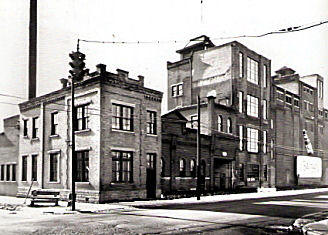
Fasenmyer
Brewery 1899-1968

In
1891, The Huntington Brewing Company built a large facility in what was then
Central City. The
first settlers had begun arriving in present-day Huntington just after the
American Revolution. By 1873, when the city of Huntington was barely two years
old, there were 4,131 breweries in the United States at the time.
In those days, the neighborhood brewery was as common as the neighborhood baker,
and beer was considered a food staple. Every town of any consequence had
breweries. Beer was generally consumed either on the brewery premises in
adjoining "brew pubs", or in saloons within a short distance from the brew
house. Patrons wishing to take beer home used containers or buckets called
"growlers".
A Portsmouth (Ohio) Brewing Company apparently shipped quantities of beer up the
Ohio River to the Huntington area beginning in the late 1800s. By the time The
Huntington Brewing Company opened in 1891, the age of the "beer barons" was in
full swing. The number of U.S. breweries had dropped to about 2,000, as larger
plants were constructed by bigger companies to make more and more beer. This
repeated itself on a different level following Prohibition. The brewery in
Central City struggled and was eventually sold to Fesenmeyer’s in 1899. It was
re-christened as The West Virginia Brewing Company and would not change hands
again until 1968.
The
Fesenmeiers had been brewing beer in Maryland since immigrating from Germany
near the end of The Civil War. They operated their new brewery in Huntington
under the West Virginia brand name until 1914 when state Prohibition forced them
out of business. The family converted the plant for other products such as ice,
cold storage, and meat-packing whenl prohibition went into effect in 1920.
When Prohibition finally ended in 1933, the Fesenmeiers got back to the art of
fine beer making. By the Spring of 1934, the family had purchased and installed
$300,000 worth of new equipment and changed the name of the brewery to
Fesenmeier Brewing Company. Production grew every year and peaked at almost
60,000 barrels in 1949..
Large national brewing companies, much as they had done in the "beer baron" heyday in the late 1800s, were ready to swallow up anyone in their way. By late 1949, the big national and larger regional brewing companies had televised commercials. The introduction of TV and the record amounts of beer advertising that came with it played a major role in their growth. That forced smaller brewers to compete on price. Production at Fesenmeier fell accordingly. The company managed to tough it out for a long time until the mid-1960s, when the younger family members were not interested in the beer business.
In the spring of 1968, a struggling but profitable Fesenmeier was sold to Huntington businessman, Robert Holley, who re-named it Little Switzerland Brewing Company. Several hundred thousand dollars were spent remodeling the brewery and outfitting it with new equipment. Product labeling was also changed and two new brands were introduced. The cost of these moves created a hole from which the small company could never dig itself out of.
In 1970, the brewery was sold to August Wagner of Columbus, Ohio, which intended to make its products in Huntington. Things did not go according to plan and August Wagner shut the brewery down in 1971. The following year, the brewery buildings were torn down.
[ Next ]